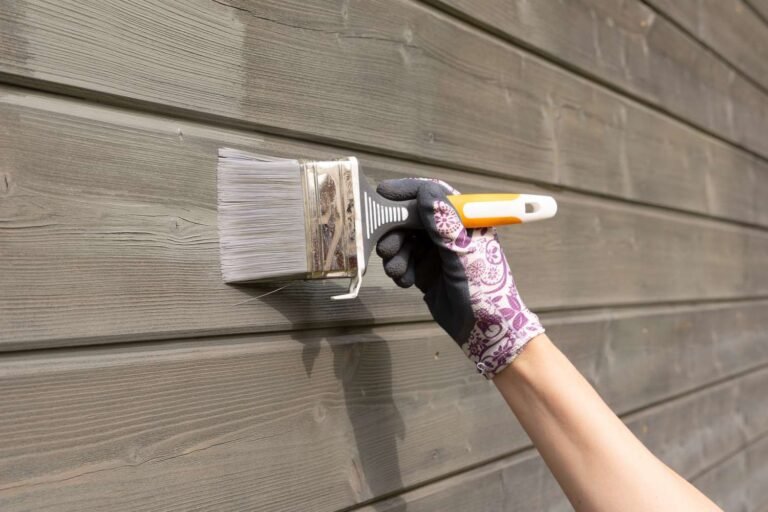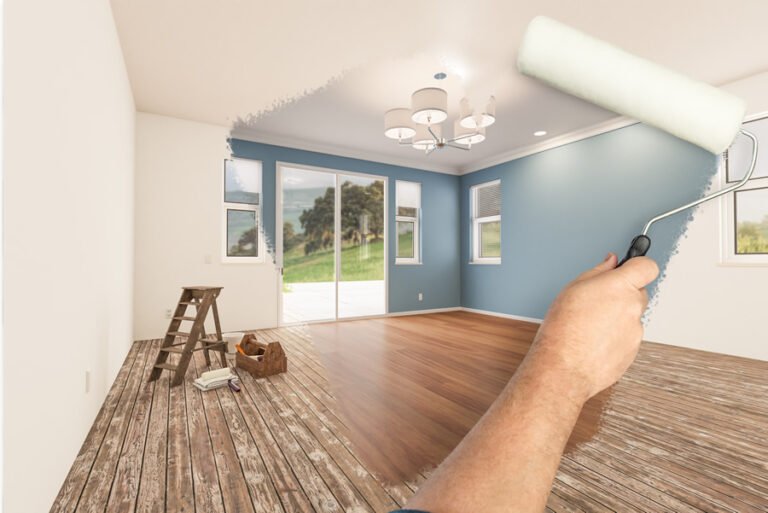You should repaint a commercial building every 3 to 10 years, based on the material, climate, and paint quality. For example, wood needs repainting every 3–7 years, while concrete lasts 5–10 years. Interior areas with heavy foot traffic, like hallways and lobbies, usually need fresh paint every 3–5 years. Delaying repainting can lead to peeling, water damage, and costly repairs. Regular inspections and quality materials help extend paint life and protect your investment.
This guide covers everything you need to know about commercial building painting schedules. You’ll learn the key factors that affect paint life, warning signs to watch for, and how to make your paint last longer.
What Affects How Long Paint Lasts?
Building Material Makes a Big Difference
Different materials need paint at different times. Concrete may require repainting every 5 to 10 years, while wood may need maintenance every 3 to 7 years.
Here’s what to expect for each material:
- Wood siding: 3-7 years
- Concrete walls: 5-10 years
- Stucco surfaces: 5-8 years
- Metal surfaces: 3-5 years
- Cement fiber: 10-15 years
Weather and Climate Impact
Harsh weather shortens paint life. Buildings that are exposed to high sunlight often need full repainting once every two to three years to keep their contemporary look.
Sun damage happens faster than most people think. UV rays break down paint chemicals and cause colors to fade. According to Sherwin-Williams research, exposure to ultraviolet radiation is one of the primary causes of paint deterioration. Rain and moisture make paint peel and crack.
Buildings in these conditions need more frequent painting:
- High sun exposure areas
- Coastal locations with salt air
- Places with extreme temperature changes
- Areas with heavy rain or snow
Paint Quality Matters
High-quality paint lasts much longer than cheap paint. Using top-quality paints can extend the lifespan of your paint job and reduce the frequency of repainting.
Premium paints from brands like Sherwin-Williams and PPG include better UV protection and weather resistance. They cost more upfront but save money over time by lasting longer.
How Often Should You Paint Different Areas?
Exterior Walls
Most exterior walls need repainting every 5-10 years. In general, you should plan on repainting exterior walls every 5 to 10 years. However, some modern exterior paints are designed to last longer, with some claiming to provide protection for up to 20 years.
The exact timing depends on:
- Which direction your walls face
- How much direct sunlight they get
- Your local weather patterns
- The quality of your current paint
Interior Spaces
Interior walls need fresh paint every 3-5 years. Generally, it’s a good idea to repaint interior walls every 3 to 5 years, depending on the level of wear and tear.
High-traffic areas like lobbies and hallways may need touch-ups more often. High-traffic areas, such as corridors and reception areas, may need more frequent touch-ups to keep them looking fresh and clean.
Special Considerations for Different Building Types
Office buildings typically follow the 5-7 year schedule for exteriors and 3-5 years for interiors.
Retail stores may need more frequent interior painting due to constant customer traffic and the need to stay current with trends.
Industrial buildings often use specialized coatings that can last 7-10 years but require professional assessment.
Warning Signs Your Building Needs Repainting
Visible Paint Problems
Look for these clear signs that it’s time to repaint:
- Peeling and flaking paint – This exposes your building to weather damage
- Fading colors – Shows the paint’s protective qualities are weakening
- Cracks in the paint – Allows moisture to get behind the coating
- Chalking – When paint feels powdery to touch
- Mold or mildew growth – Indicates moisture problems
Surface Damage
Paint problems often reveal bigger issues. When anything like this occurs, the surface of the structure is left exposed, which may result in damage, rust, and an infestation of various pests.
Check for:
- Exposed wood or metal
- Water stains
- Rust spots
- Gaps where paint has pulled away
What Happens If You Wait Too Long?
Costly Repairs
Delaying repainting leads to expensive problems. When paint fails, your building’s exterior becomes vulnerable to:
- Water damage and rot
- Metal corrosion and rust
- Pest infestations
- Structural deterioration
Professional Image Issues
Your building’s appearance affects your business. Some customers use aesthetic factors to decide if they want to patronize the company. A repainted building gives the impression that your business is welcoming, and you offer quality services.
A well-maintained exterior:
- Attracts more customers
- Improves employee morale
- Maintains property value
- Shows professionalism
How to Make Your Paint Last Longer
Choose Quality Materials
Invest in premium paint for better longevity. Investing in high-quality paints from reputable brands like Benjamin Moore, Sherwin-Williams, Behr, and PPG can prolong the lifespan of your paint job and provide better protection against the elements.
Quality paint features:
- Better UV protection
- Superior weather resistance
- Higher coverage per gallon
- Longer warranty periods
Proper Surface Preparation
Good prep work is half the job. Professional painters spend significant time preparing surfaces because it directly affects how long the paint will last.
Key preparation steps include:
- Cleaning all surfaces thoroughly
- Repairing cracks and holes
- Removing loose or peeling paint
- Priming bare surfaces
Regular Maintenance
Simple maintenance extends paint life significantly. One of the best ways to improve the longevity of a paint job is regular cleaning of the exterior of the building.
Annual maintenance should include:
- Washing exterior walls
- Touching up small chips and scratches
- Checking for early signs of problems
- Addressing water leaks quickly
Best Times to Paint Commercial Buildings
Seasonal Considerations
Spring and fall offer ideal painting conditions. In most regions, spring and fall are considered ideal times for exterior painting, as the weather is mild and humidity levels are moderate.
Avoid painting during:
- Extreme heat or cold
- Rainy seasons
- High humidity periods
- Windy conditions
Business Operations
Plan around your business schedule. During the downseason, it’s an opportune time to schedule painting projects. Repainting your commercial building during slower periods allows for minimal disruptions to daily operations.
Consider these timing factors:
- Seasonal business patterns
- Customer traffic levels
- Employee schedules
- Weather forecasts
Commercial Painting Costs and Planning
Budget Planning
Quality painting is an investment in your property. A good quality paint should last at least five years on your commercial building’s exterior siding.
Cost factors include:
- Building size and complexity
- Paint quality and type
- Surface preparation needs
- Labor and equipment costs
Working with Professional Painters
Choose experienced commercial painting contractors. If you are using a local painting company, ask for references and examples of sites they have worked on.
Look for contractors who:
- Have commercial painting experience
- Provide detailed written estimates
- Use quality materials
- Offer warranties on their work
Industry Standards and Regulations
Professional Recommendations
Industry experts agree on general timelines. One of the nation’s leading paint providers, Sherwin-Williams, says the average repaint cycle is every five to seven years.
Legal Requirements
Some locations have specific requirements for commercial properties. New York legislates that units must be repainted every three years. In Los Angeles it’s every four.
Check your local regulations for:
- Mandatory repainting schedules
- Safety requirements
- Environmental compliance
- Building code standards
Creating a Maintenance Schedule
Annual Inspections
Set up regular paint inspections. Check your building’s exterior at least once per year, preferably in spring before harsh summer weather.
During inspections, look for:
- Color fading or chalking
- Peeling or cracking paint
- Water damage signs
- Areas needing touch-ups
Documentation
Keep records of your painting history. Track when you painted different areas, what products you used, and any problems that developed.
This information helps you:
- Plan future painting projects
- Identify problem areas
- Make warranty claims if needed
- Budget for maintenance costs
Professional Assessments
Get expert opinions every few years. Professional painters can spot problems early and recommend the best timing for repainting projects.
Benefits of professional assessments:
- Expert problem identification
- Accurate cost estimates
- Product recommendations
- Timeline planning
Environmental Considerations
Eco-Friendly Options
Choose low-VOC paints for better health and environment. Nearly 75% of coatings sales worldwide are now for products using environmentally sound coating technologies such as waterborne, powder, and high solids.
Environmental benefits include:
- Reduced air pollution
- Better indoor air quality
- Less toxic waste
- Energy savings
Sustainability Practices
Proper paint disposal protects the environment. The American Coatings Association reports that 97% of all waste solvents from paint and coatings manufacturing facilities are now reclaimed for future use. Work with contractors who follow environmental guidelines for:
- Paint disposal and recycling
- Surface preparation waste
- Equipment cleaning
- Chemical storage
Final Thoughts
Commercial building repainting follows a general schedule of every 3-10 years, but your specific needs depend on multiple factors. Wood surfaces typically need attention every 3-7 years, while concrete can go 5-10 years between paint jobs.
Pay attention to your building’s condition rather than just following a calendar. Look for fading, peeling, or cracking paint as signs it’s time for a refresh. Regular maintenance and high-quality paint can extend the time between major repainting projects.
The key to successful commercial painting is working with experienced professional painters who understand your building’s specific needs. They can help you choose the right materials, plan the best timing, and create a maintenance schedule that protects your investment.Ready to assess your commercial building’s painting needs? Contact us for a professional evaluation and free estimate. Our experienced team can help you develop a painting maintenance plan that keeps your building looking professional while protecting your investment.




